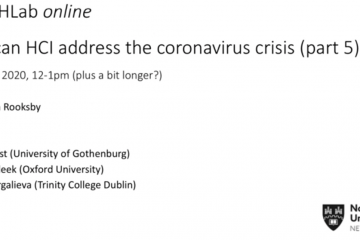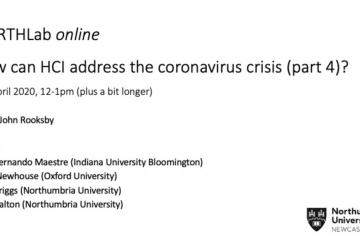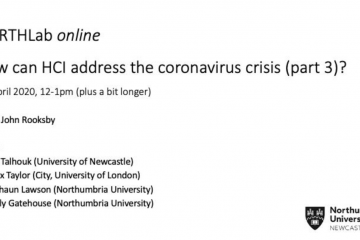We held our second NORTH Lab panel on HCI research for covid-19 this week. Following on from last week (you can read a summary of the first panel here) It was nice to be joined by another 60-ish people, this time mainly across the UK and Europe. And while last week we saw insights into people’s living rooms and home offices, this week personal life crept in even more, with Pandora the cat, Coco the dog and a couple of children and babies making an appearance throughout the call. It’s very humanising to see this side of colleagues, which is often forgotten about in our sterile offices. Below is my summary of what each of the four panellist presented and some of the discussions that emerged.
**As a disclaimer, the final panel talk touched on the topic of death and bereavement**
Dr Opeyemi Dele-Ajayi (Northumbria University) – EdTech research in the age of pandemics
Opeyemi has been researching education technology in developing countries (Nigeria, Kenya, Uganda, among other countries in Africa), but most of his work is drawn from the Nigerian context. He briefly mentioned two projects he’s currently working on:
- The first one, DIGITSTEM funded by the World Bank, is looking at how teachers’ needs in the classroom can be better understood and how technology can help solve them. This includes also developing a local STEM curriculum and kits through co-design approaches that can be integrated in a practical way.
- The second project, BDEI funded by Microsoft, is centred around increasing digital literacy in teachers for primary and secondary schools so they feel more comfortable and able in using EdTech.
With Nigeria being the most populous country, there is also the highest number of out-of-school children in the world (13.2 million!), especially as a result of crisis and terrorism threats. Schools are overpopulated and as a result the classroom experience is generally poor. However, due to an increasing mobile penetration in homes with 140million mobile phone users, there is a potential for technology-enhanced learning to bring a better experience of education.
One of the main challenges in widespread adoption of EdTech is the scepticism of teachers. While they see the usefulness of EdTech, and there are potential ways around access to the technology, the scepticism is rooted in the usability experience and digital literacy. This is because most of the tools are WEIRD-ly designed (Western, Educated and from Industrialised, Rich and Democratic countries) and there is a well-known disconnect between developers of such tools and users in developing countries. There is also a use-gap, whereby the understanding of how to use mobile technology is not necessarily consistent across the population.
It becomes obvious that in order to participate and benefit from EdTech, accessibility, usability and digital literacy are key. This then leads to 4 main challenges that HCI can address, whilst keeping in mind users, their context of use and how solutions are implemented:
- How do we design with inclusiveness and diversity as the foundation for every other thing?
- What are the barriers to adoption and implementation in the variety of contexts, especially amongst the most marginalised?
- How do we better understand and predict the changing nature of education and work?
- How can we provide young people (and their influencers – teachers and parents) with the opportunity to gain high levels of digital literacy in order to take advantage of EdTech? How can we make sure that students – especially in developing countries – become more active participants in using technology to improve their learning?
Offering digital devices and tools is not always the solution. But we need more work to understand the barriers, so that we can better support those who want to use EdTech.
Thinking about the covid-19 implications, how will social distancing impact digital learning in places where there already is a bigger digital divide? Currently, the dedicated infrastructure is still very limited for teaching online, and material are not designed to be delivered online. However, teachers are finding creative workarounds with existing digital tools that could translate into useful solutions. For example, although the mobile devices that people have at home are so varied and there is little consistency, one tool that is commonly widespread is WhatsApp. Some schools in Nigeria have been developing video teaching material and sharing it over WhatsApp.
Dr Kellie Morrissey (School of Design, Limerick) – Lessons for Covid-19 form dementia and care work in HCI
Dementia is a perennial topic in the fields of HCI and Design for Health and Wellbeing, so there is lots of research we can draw from, for example around the experience of living in nursing homes. Given the high levels of isolation and the reduced cognitive functioning, there are at least 3 parallels or lessons we can draw.
- Touch – while we are actively avoiding it now, touch has actually profound emotional and communicative implications. As Julia Twigg states, touch can even be “a vector of status, authority and dominance”, while at the same time also be a sign of intimacy. When thinking about design and materiality, especially in a situation where our sense of touch is removed, researchers like Jayne Wallace have done extensive work to look at how we define digital materials and even in Kellie’s own work within dementia, there are design opportunities for hand-holding experiences.
- Being together – given the current pandemic, we’ve all experienced isolation in some for or another, and nursing homes are a place where this experience is even more extreme. In the context of health and wellbeing, HCI research has been looking at various forms of telecare for a long time already, so there is definitely opportunity there to draw some parallels. In the words of McCarthy & Wright, Kellie reminds us of the experience of summers in Montreal, where Probyn would interact with neighbours on the balconies and spend most of the time. And now during this pandemic, we see the similar behaviours in Italy and Spain, with neighbourhoods coming together to play music or even exercise.
- Freedom(s) – Goffman has taught us about institutionalism and the mental health implications. Currently, many of us are feeling an encroaching squeeze, and this gives us an increased human rights’ recognition. When we think of people with dementia, we often assume that they can’t protest or resist, but with their wanting to go home and their wandering they are actually showing acts of resistance. The approach that HCI has taken in this case with people with dementia is to either track them or do ‘therapeutic lying’, creating fake bus stops, fake villages, etc. While there might be a place for these strategies, we also need to think carefully about how and when these are done.
Kellie concluded with 4 summary provocations for HCI:
- We need to design in ways of participating in our communities that respect space, difference and singularity – we can leverage digital methods to do this
- Let’s get serious about the structural and financial barriers impeding telecare and remote connection in nursing homes and other institutions
- How can we design opportunities for tactile touch and presence while reducing infection risk in care settings
- We might use this opportunity of having our freedom (very gently and necessarily) curtailed to muse on how it feels for other ‘inmates’
Prof mc schraefel (Electronics and Computer Science, Southampton) – Inbodied interaction: body as site of adaption
We often talk about our embodied experiences, as has happened in the panel so far, but mc proposes his idea of inbodied interaction to think of how we are wired psychologically, physiologically, neurologically as part of a physical environment.
Ultimately, by understanding out inbodied interactions we can improve our design and efficacy as physical and social beings. Several questions were raised, such as ‘how do we use physiology and neurology to better enable teams to work virtually and better together? There are several aspects that need to be considered, such as the sense of synchrony, touch or vibrations, eye contact, but also how we build trust through a series of physiological cues. Latching on to what Kellie was mentioning, the same can be applied to the sense of touch and its importance, especially in times when we are isolated from loved ones.
This horrible gift we’ve been given, of not having a choice of actually sitting at our desk in our office, of not being able to connect with others in the same way, maybe is actually an opportunity to say ‘how can we feel better? How can we change to make us feel better?’ Sometimes it takes something as big as this pandemic to highlight the significance of our work and think about broader benefits.
mc launched a call for all of us to keep a light touch comfort/discomfort diary of what we feel on a daily basis during this pandemic, to note down what feels comfortable and uncomfortable, as a way of unpacking the why and explore how we can build a new normal.
To find out more about work on inbodied interaction, please visit: www.wellthlab.ac.uk
Dr Stacey Pitsillides (Northumbria University) – Death and technology in a pandemic
Stacey used her experience of understanding death and memorials in second life and games, along with work in palliative care to draw parallels and implications for the current situation.
Concerns of palliative care often include things like quality of life, advance care planning, pain and symptom management and support for caregivers. With covid-19, these concerns raise new questions, as advance planning has become more essential than ever, yet these decisions may need to happen over a long distance.
- What happens to people who are dying of something other than covid-19?
- How can we support the physical, social, psychological and spiritual needs of patients and their close ones with covid-19?
- For those saying goodbye by videolink, is it possible or advisable to die at home? Several customs and traditions involve touching the dead body or dressing it and these practices become very difficult and we need to consider implications or facilities to avoid spreading the virus further.
Just like we saw in last week’s panel, different occupations are suddenly becoming key workers, such as in this case: funeral directors. While livestreaming of funerals has been happening for a while, there is a big psychological shift happening and workers are not necessarily prepared. Slack channels and Facebook groups are cropping up to give funeral directors support, and at the same time, death also becomes a tool to talk about covid-19 on social media. There have been new practices emerging with funeral services being performed over Zoom, communal water being removed for covid-19, or even the Madonna di Loreto being toured around in a private jet in Italy to bring comfort (something that hasn’t been done since the plague).
Lots of Stacey’s work focuses on public engagement and in the context of covid-19, the question is raised: can we still be death positive during this pandemic? How does one deal with bereavement and social isolation?
If you would like to volunteer to give a talk, in one of next online panels, please get in touch with
John Rooksby
john.rooksby@northumbria.ac.uk
Take care people!
RESOURCES MENTIONED
- Cheap standing desk https://www.amazon.co.uk/Paper-Maker-Cardboard-Portabe-Standing/dp/B07RB4JKQJ/ref=as_li_ss_tl?_encoding=UTF8&psc=1&refRID=J28H3EJ60SSHZJG11S4H&linkCode=sl1&tag=nopainnopain-21&linkId=03f2c97c8b77b9225d2cbec6768806e3&language=en_GB
- Deep project: https://www.dementiavoices.org.uk/wp-content/uploads/2015/03/DEEP-Guide-Language.pdf
- Helping Hand initiative in Newcastle: https://www.helpinghandproject.co.uk/
- Re-engage: https://www.reengage.org.uk/
- CityLife line in Newcastle https://www.newcastle.gov.uk/services/public-health-wellbeing-and-leisure/public-health-services/coronavirus-covid-19/citylife
- Somatics https://en.wikipedia.org/wiki/Somatics
- Campaign for dignity in dying https://www.dignityindying.org.uk/
- Love after death https://loveafterdeath.co.uk/



0 Comments